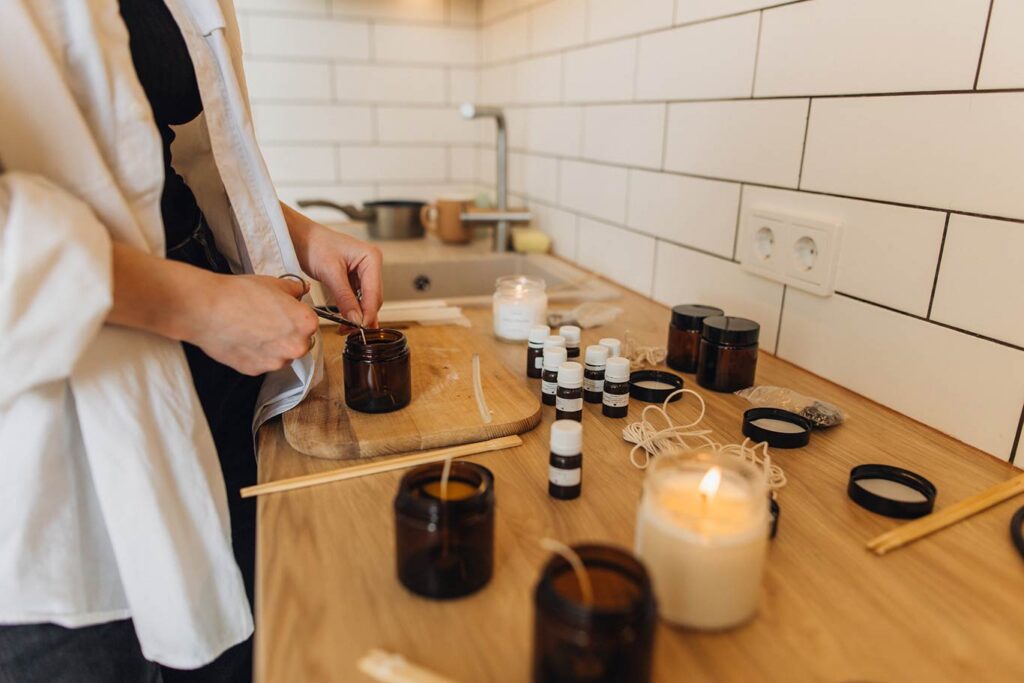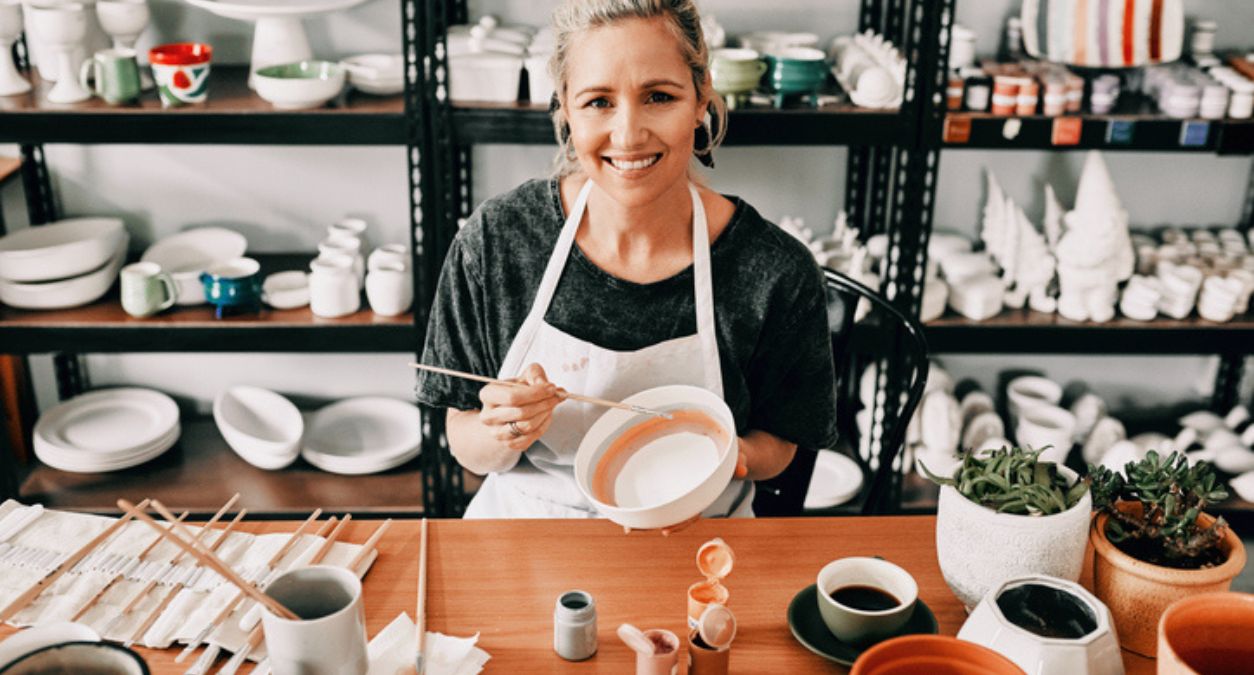Table of contents
Table of contents
Table of contents
Contributors
My main focus is managing the blog and product content for the Protectivity website ensuring everything aligns wi...
If you’re wondering how to sell your crafts online, it’s certainly feasible, with a low barrier to entry. You can start whenever you’re ready, with little more than a suitable home workspace and a few supplies. The sooner you start honing your skills, the better, so you can start to establish your place in the market. Of course, further down the line you can create a business plan, define your branding and find out the most effective marketing channels for your audience.
If you’re wondering how to sell arts and crafts online, read our extensive guide for everything you need to know.
Decide on a product
Before you even think about how to sell handmade crafts online, you have to come up with a product worth putting out there. You’ll want to create high-quality crafts, which have something unique to offer but are also in demand. You can make anything from handmade jewellery and home decor to digital prints and knitwear.
Before you start designing or constructing anything, consider your skills, interests, and target market. Do your research, read trade publications, consult Google search results, browse seller sites and research hashtags on social media. Once you’ve identified on-trend products and settled on an idea, check out what similar crafts are selling for and get to know what kind of competition is out there. See how much existing products are selling for.
After you’ve found your idea, you’ll naturally be excited to start offering it to the world. It’s important that you take your time with the creation stage when you start, however, rather than rushing something out. Make sure your products are durable and meet the expectations of your target audience.

Create your brand
In order to create a strong brand, you’ll need to understand your ideal customers, including their preferences and pain points. Tailor your brand to resonate with this specific demographic. Share the story of your craft business in emails, blogs, the about page of your website (if you have one) and social posts. Explain why you started, what inspires you, and how your crafts are made. Customers often connect more with a brand that has a compelling, emotionally-driven narrative.
Of course, you’ll need to decide what to call it. Choosing a name for your craft business is crucial as it represents your brand identity. Consider combining words that evoke creativity, craftsmanship, and uniqueness. Try alliteration, rhyming, or wordplay to make it catchy, although you don’t want to go too humorous unless it’s on-brand. If you’d rather have an aspirational brand, you can keep the name in line with a more premium feel. It will need to be easy to spell and pronounce, as well as having an available website domain. Keep it relatively short to make it easily memorable. Take your time to brainstorm and seek feedback from friends and family to make sure your chosen name resonates with your vision and target audience.
You’ll also need to design a logo, or hire a professional creative to design one, which reflects your brand style and establishes a visual identity you’re happy with. A well-crafted logo is a powerful tool to leave a lasting impression on your customers. Start by reflecting on your product’s essence and your company values. Use colours, fonts, and imagery that convey creativity, handmade quality, and uniqueness. Simplicity is key, as a clutter-free design is more memorable. Incorporate craft-related elements, such as tools, materials, or your signature product. Sketch ideas, create mood boards and seek inspiration from other craft businesses. Your logo should be versatile, working well on various online platforms and offline materials.
Create branded materials such as business cards, packaging, labels, and thank-you notes. These should carry your logo and branding elements. Choose a colour palette and fonts that align with your brand’s personality. They should be consistent across everything your brand is associated with.
Invest in good product photography. This is crucial for your craft business because it can significantly impact how your products are perceived by potential customers. Use natural light, high-resolution images, and multiple angles to showcase your crafts. The better your photos, the more likely you’ll make sales. Use a clean, uncluttered background that doesn’t distract from the product. A plain backdrop, seamless paper roll, or props that enhance the product can work well. Position the product centrally or off-centre, depending on the composition you prefer.
What is the best website to sell crafts?
The question of which platform/s you’ll make your products available on is highly important when deciding how to sell crafts online in the UK. In addition to your own website, there are a range of online marketplaces you can choose from.
Here’s an overview of online platforms for selling crafts:
Etsy: Etsy is still the biggest marketplace for handmade products, with over 88.3 million buyers last year. It also has low seller fees.
Not on the High Street: NOTHS is renowned for handmade crafts, making it a go-to destination for people searching for unique gifts.
Amazon: There’s vast potential from this retail giant serving millions of customers, with a dedicated platform, Amazon Handmade.
Ebay: With hundreds of millions of monthly visits, Ebay is user-friendly for listing your products and offers useful selling tools.
Facebook Marketplace: if you want to know how to sell crafts online for free, this is a the only platform that doesn’t charge. You can sell to people within 100 miles.
Shopify: With a customisable online store featuring thousands of apps to make use of, you can sell as much as you like when you set up your own site on Shopify.

How to start selling crafts online
Once you’re ready to sell online, these are some of the key areas to bear in mind:
Pricing: Calculate your costs by working out the total of materials, labour, shipping, and platform fees (once you know where you’ll sell), then adding a reasonable profit margin. You’ll need to strike a balance between offering customers a competitive price and charging your worth.
Copywriting: Write copy for the different touchpoints your brand will sit on, such as transaction pages, social media, emails and your own website, if you’ll have one at this stage. Decide on the tone of voice you want to use when addressing your customer. Write detailed and appealing product titles, descriptions and articles, highlighting the unique features and benefits of your crafts.
Shipping: Determine your shipping methods and rates. Your items will need to be securely packaged to prevent damage during transit. Offer tracking and delivery confirmation if possible.
Payment processing: Set up secure and convenient payment options for your customers. PayPal, credit cards, and buy-now-pay-later options like Klarna and Clearpay are popular payment methods to consider.
Customer service: Provide excellent customer service. Respond promptly to inquiries, address issues professionally, and maintain a good reputation for your business. This will keep customers coming back and encourage them to recommend you to others.
Legal and tax considerations: You’ll need to comply with local laws and regulations for online businesses, paying attention to your tax obligations. You might need to register your business, get a resale licence, or collect sales tax in certain cases. Consult with a legal or financial professional if necessary, as this could save you money and avoid costly issues.
Organising your business operations
Good organisation and clear processes, even if you’re working alone from home and aren’t creating vast amounts of product yet, will help you to run your craft business effectively. If you have these in place from the start, you’ll have the right mindset for continuing to grow and be ready for the challenge. Here are some tips to help you manage your day-to-day operations:
Organise your workspace: Keep your craft supplies and finished products in dedicated areas, making use of different containers and having a methodical filing system for orders, invoices and other paperwork. Label and categorise materials for easy access.
Set up an inventory system: Establish a tracking system to record the quantity and details of each item. You can use straightforward spreadsheets or more sophisticated inventory management software.
Monitor stock levels: Regularly check your inventory levels. Set reordering points for materials to ensure you order more before you run out. This helps prevent backorders and production delays.
Prioritise fast-moving items: Pay special attention to crafts that sell quickly or seasonally. Keep more of these items in stock to meet customer demand.
Batch or create in small batches: Consider making crafts in small batches, rather than producing in large quantities. This allows you to adjust your production based on sales trends and reduce the risk of overstocking.
Manage lead times: Be aware of lead times for your materials. Some materials may have longer lead times or require international shipping. Plan your orders accordingly.
Safety stock: Maintain a safety stock level for your most essential materials. This extra buffer helps prevent shortages in case of unexpected high demand or delays in supply.
Use technology: Consider using inventory management software to streamline your processes. These tools can automate reordering, track sales trends, and provide real-time inventory data.

How to make money selling crafts online
If you’re wondering whether selling crafts online is profitable, the answer is that it can be if you approach it in the right way. Of course, you need to start with a good product, but even then, there are no guarantees and you have to work hard to promote it. Rather than there being a magic formula for how to make money selling crafts online, it takes a little experimentation, an open mind and a willingness to adapt and try new ways of selling your wares.
Finding success can therefore be a gradual process, as it takes time and effort to build a strong brand and a loyal customer base. Be open to refining your strategies as you gain experience. Here are some of the most important tactics that will help you to increase your online income from selling crafts:
Marketing: Try using social media, email marketing, and paid advertising to promote your crafts. See what works best for you so that you can assess where it’s worth investing your time. Engage with your target audience, share your creative process, and build a community around your brand.
Search engine optimisation (SEO): Use relevant keywords for SEO, so that your customers can find you in Google when searching for terms related to your product.
Feedback and reviews: Encourage satisfied customers to leave reviews. Positive testimonials build trust with potential buyers, as people like to see social proof before they commit to buying.
Nurture your business for long-term growth
Growing your business is a process that requires patience, adaptability and dedication. There are no guarantees for when it will start being profitable, as this is influenced by elements like market demand, product quality, and effective marketing. Many crafters start as a side hustle and gradually expand as they gain experience and a loyal customer base.
As your craft business grows, maintain a future-focused perspective and keep these tips in mind:
Price your products appropriately: this is crucial for the success of your business and as you grow, you can think about whether to increase your prices.
Harness your data: Analyse your sales data, customer feedback, and website analytics to identify areas for improvement.
Listen to customer feedback: Continuously improve your products and services based on the input of those who matter most.
Diversify your products: Consider expanding your product line to include related items, such as lifestyle products or accessories.
Network and collaborate: Broaden your reach by building relationships with other crafters, artisans, retailers, and potential collaborators.
Commit to ongoing learning: Keep up with industry trends and developments to stay competitive.
Get Crafters Insurance with Protectivity
Protecting your wares is made much easier with specialist craft insurance. Whether you’re an online seller or heading out to craft fairs, it makes sense to be as prepared as possible for any kind of incident.
Protectivity’s Crafters Insurance is designed to give protection from customer or third-party claims, with Product Liability Insurance for the event of accidental damage to someone else. You can also opt for Craft Fair Insurance, specifically created for stallholders.
Find out more and get an instant quote tailored to the needs of your business. Get in touch if you have any queries at all.
Get Crafters Insurance from Protectivity
*Disclaimer – This blog has been created as general information and should not be taken as advice. Make sure you have the correct level of insurance for your requirements and always review policy documentation. Information is factually accurate at the time of publishing but may have become out of date.
Last updated by


































